Integrated Public Alert & Warning System (IPAWS) • Summer 2022
In This Issue
IPAWS Users Conference
Celebrating 10 Years of WEA
FEMA Upgrades New Orleans PEP Station
Monthly Proficiency Demonstrations
New IPAWS Infographic
IPAWS Alerts on Digital Billboards
PBS WARN: A Live Look at WEAs
Impact-Based Weather Warnings
Coming Events & Webinar Recordings
FCC Rule Changes for WEA & EAS
New Alerting Authorities
IPAWS Users Conference
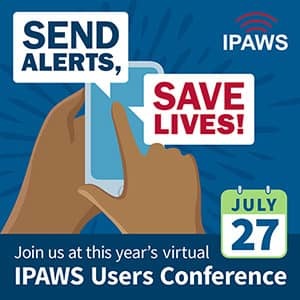 The online Users Conference on Wednesday, July 27, 2022, will introduce public safety officials not yet using the Integrated Public Alert and Warning System (IPAWS) to this powerful tool for saving lives and protecting property.
The online Users Conference on Wednesday, July 27, 2022, will introduce public safety officials not yet using the Integrated Public Alert and Warning System (IPAWS) to this powerful tool for saving lives and protecting property.
Discover how to obtain grants and funding for IPAWS training, exercising, planning, and alerting tools. Witness a live test of Wireless Emergency Alerts, learn best practices from current Alerting Authorities, and gain insights on effective messaging from a social scientist who studies public reaction to alerts. Learn the four easy steps to get on-board as a new IPAWS Alerting Authority.
The Users Conference is designed for public safety officials interested in leveraging IPAWS capabilities in their jurisdictions. Current Alerting Authorities will also benefit from refreshing their knowledge.
Registration is free. Find the agenda and registration at this link. Please share this information with those not yet participating with IPAWS.
Celebrating 10 Years of WEA
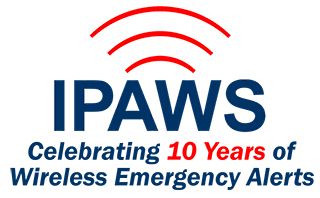 This year FEMA celebrates the 10th anniversary of Wireless Emergency Alerts (WEA)! Originally called the Commercial Mobile Alert System or Personal Localized Alert Network, the FCC renamed them Wireless Emergency Alerts in 2013.
This year FEMA celebrates the 10th anniversary of Wireless Emergency Alerts (WEA)! Originally called the Commercial Mobile Alert System or Personal Localized Alert Network, the FCC renamed them Wireless Emergency Alerts in 2013.
This new system brought public alerting into the 21st century and into the homes and pockets of the 97% of Americans who own a cellular mobile phone.
In June 2006, following criticism over the federal response to Hurricane Katrina, President George Bush signed an Executive Order to establish a new program to integrate and modernize the nation's existing public alerting systems. The Executive Order 13407 directed the Secretary of Homeland Security to implement this policy:
"It is the policy of the United States to have an effective, reliable, integrated, flexible, and comprehensive system to alert and warn the American people in situations of war, terrorist attack, natural disaster, or other hazards to public safety and well-being (public alert and warning system), taking appropriate account of the functions, capabilities, and needs of the private sector and of all levels of government in our Federal system, and to ensure that under all conditions the President can communicate with the American people."
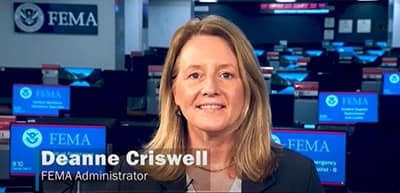
See the FEMA Administrator's remarks on YouTube.
Almost a month later, the House of Representatives introduced the Warning, Alert and Response Network (WARN) Act, to establish "a voluntary National Alert System to provide a public communications system capable of alerting the public on a national, regional, or local basis to emergency situations requiring a public response."
Today IPAWS is that comprehensive system envisioned by the President and the WARN Act. The WEA component of IPAWS was first deployed in 2012, and FEMA began helping public safety officials across the U.S. and its territories learn to use the new system.
FEMA partnered with the National Weather Service and Federal Communications Commission to educate the public about WEA. But national news coverage of several early uses of WEA by state and local authorities helped broaden the public's knowledge of how alerts to mobile phones could keep them safe. Only a few months after the first WEA was sent, the system was used to alert New Yorkers to the danger posed by Hurricane Sandy, with blizzard, flash flood and evacuation warnings disseminated depending on location.
Fast forward to 2022 and more than 1,700 Alerting Authorities are now authorized to use IPAWS to alert and warn the public, and more than 70,000 WEAs have been sent to help save lives and protect property.
IPAWS is especially proud of the contribution WEA has made to child safety. WEA is part of the AMBER Alert system operated by the National Center for Missing and Exploited Children (NCMEC) for the U.S. Department of Justice. To date, NCMEC directly credits WEA with the recovery of 123 abducted children.
WEA and the entire IPAWS system demonstrates its value daily. We urge Alerting Authorities to take full advantage of training and support from FEMA IPAWS so you can help save as many lives as possible using this powerful tool for public safety!
FEMA Upgrades New Orleans PEP Station
FEMA has completed an important emergency broadcast facility modernization project at Audacy, Inc. radio station WWL AM/FM in New Orleans.
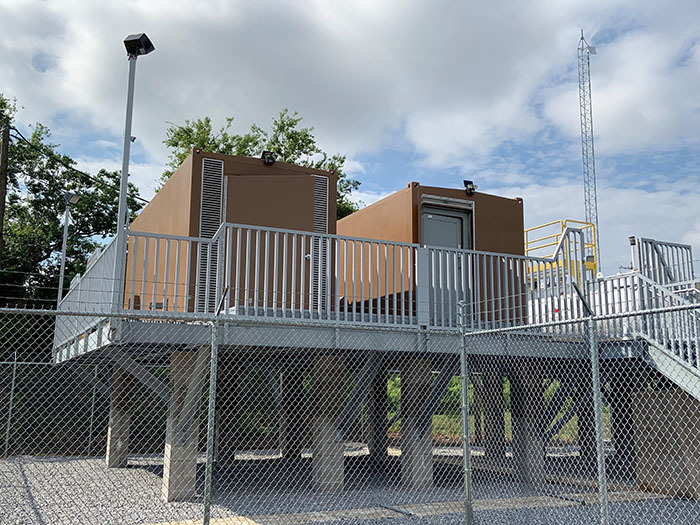
WWL serves as a Primary Entry Point (PEP) station, the only one in Louisiana, for FEMA's National Public Warning System (NPWS), maintained under IPAWS to provide critical information to the public before, during and after incidents and disasters.
PEP stations serve as the primary intake source of initial broadcasts for a national alert. FEMA equips these stations, which are operated by local station personnel, with backup communications equipment and power generators that enable them to continue broadcasting information to the public during and after an emergency, including conveying official alerts to communities regionally and nationwide.
These free-standing emergency studios, located at the radio transmitter sites, are designed and hardened to withstand natural disasters and acts of terrorism. The 77 current PEP stations reach more than 90% of the U.S. population, helping ensure that the President can alert and warn the public under all conditions. WWL is the 15th PEP station to complete the all-hazards upgrade.
IPAWS Monthly Proficiency Demonstration Scenarios
IPAWS Alerting Authorities (AA) are required to perform Monthly Proficiency Demonstrations (MPDs) using the IPAWS Technical Support Services (TSS) environment to maintain IPAWS access. The purpose is to increase AA proficiency and confidence when issuing alert and warning notifications, and most importantly to lessen the risk of errant messages.
The following rules apply:
Miss 1 month = friendly reminder
Miss 2 months = notification to your state IPAWS authority
Miss 3 months = risk of having IPAWS connectivity disabled
The IPAWS Customer Support Branch monitors TSS activity for MPD compliance. The IPAWS Office does not want to disable anyone's connectivity to IPAWS. So, to encourage participation, IPAWS introduces Scenario-Based MPDs: pre-developed short scenarios to make your proficiency demonstration experience more interesting and useful.
Scenario-Based Monthly Proficiency Demonstration
A Scenario-Based MPD leverages an adjustable template composed by Technical Support Services Facility (TSSF) staff. The scenarios cover a variety of hazards and incidents. They are created to be flexible, scalable and adaptable, which allows you to modify the scenarios to fit the needs of your jurisdiction(s).
Scenario-Based MPDs include a situation followed by 4-5 applicable questions and are similar to mini-table top exercises (10-15 minutes). The purpose is to facilitate collaboration among participants and trigger critical thinking / decision-making, reducing the feeling of a routine process.
Benefits include:
- Evaluation of decision-making processes regarding public notification;
- Assessment of internal policies and procedures; identify gaps;
- Determination of IPAWS effectiveness; and
- Development of templates for incidents.
IPAWS TSSF staff are available to assist you with performing a Scenario-Based MPD. Support is typically provided virtually, via webinar, but we welcome visitors to the TSSF.
You can reach the TSSF at 1-84-IPAWSLAB or 1-844-729-7522. You can see example scenarios and questions on the IPAWS MPD web page at this link. Additional resources, such as the Event Code Glossary and the Alert Standardization Checklist, can be found in the IPAWS Library.
New IPAWS Infographic
This image is available for your use in social media, presentations, training, etc. You can download a large (3000x1711px) version from the IPAWS website at this link.
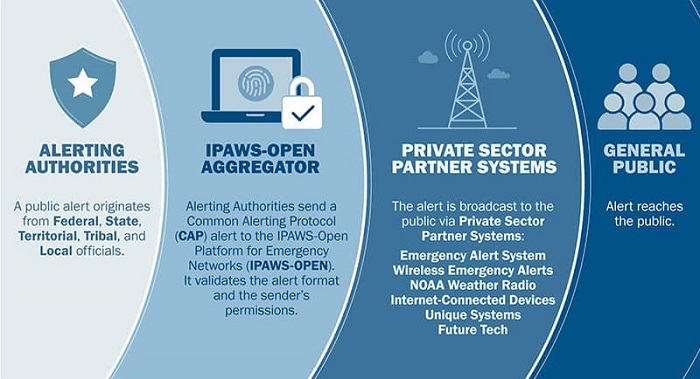
IPAWS Alerts on Digital Billboards
In December 2020, FEMA announced that Lamar Advertising Company would display IPAWS emergency alerts on its digital billboards. Lamar is one of the world's largest outdoor advertising companies.
In the first half of 2022 alone, Lamar displayed more than 140,000 IPAWS alerts on its network of more than 4,000 billboards across the nation. The alerts come from the IPAWS All-Hazards Information Feed and are placed on billboards in locations that correspond to the FIPS Codes in the feed. An example appears below.
Companies interested in becoming Alert Redistributors should contact the IPAWS Office.
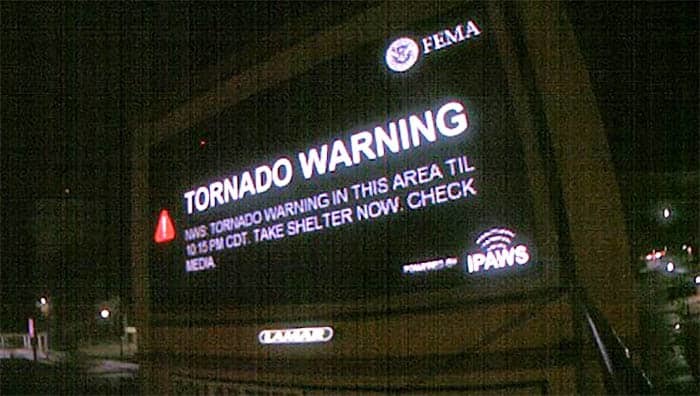
PBS WARN: A Live Look at WEAs
PBS WARN (Warning, Alert, Response Network) provides a backup dissemination method of Wireless Emergency Alerts (WEAs) should IPAWS connection to wireless providers ever be interrupted. PBS WARN uses the Public Broadcasting Service infrastructure.
All WEAs sent via IPAWS are received and displayed by the PBS WARN website. The map available at warn.pbs.org shows all active WEAs that WARN is broadcasting in real time. Past WEAs can be viewed dating back to October 2020.
Use the map for situational awareness, message history, and a quick unofficial way to verify that a WEA was successfully sent.
The map is only a reflection of WEAs. It does not display alerts sent over the Emergency Alert System (EAS) or Non-Weather Emergency Messages (NWEM). For more information, contact the PBS WARN team at warn@pbs.org.
Examples from PBS WARN
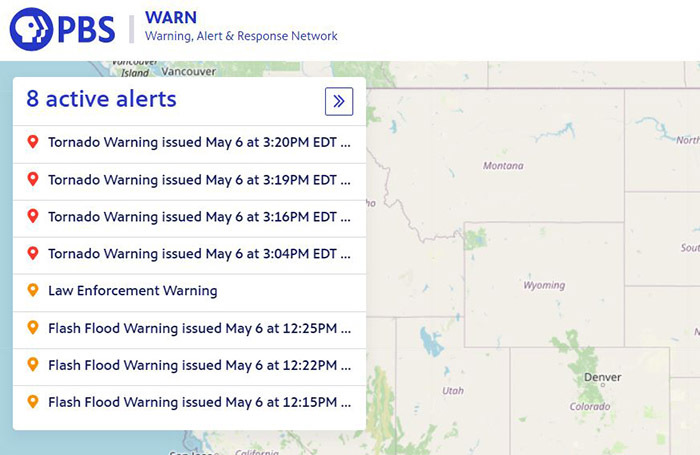
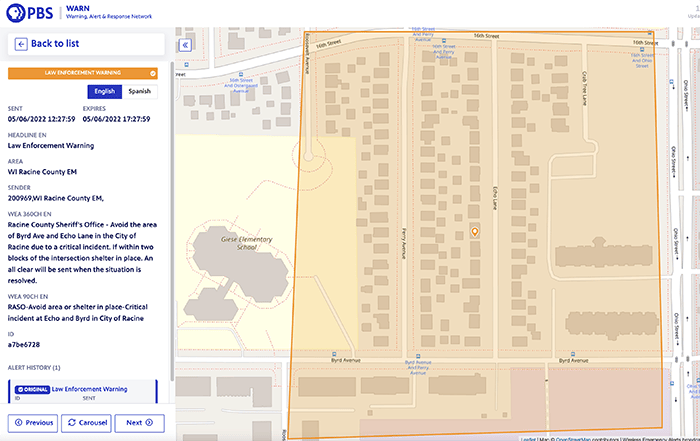
Click this image to view larger version
Impact-Based Weather Warnings
The National Weather Service (NWS) is now issuing Severe Thunderstorm Warnings when a severe storm is happening or imminent. These warnings are impact-based, focusing on the expected storm impacts, allowing for more precise communication and recommended actions.
The NWS infographic below lists the severe weather warnings that trigger Wireless Emergency Alerts. Find more information from NWS at this link.
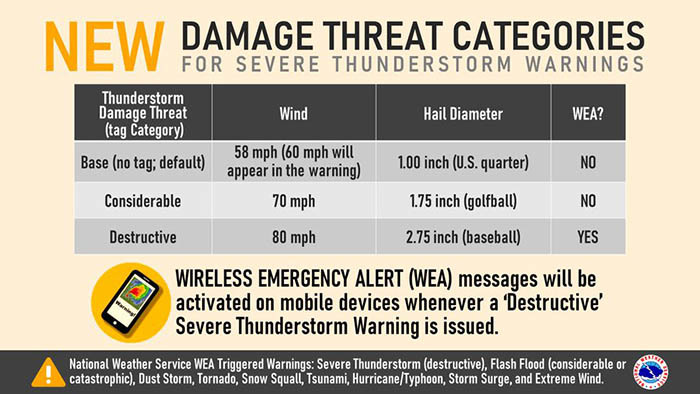
Coming Events
July 21–24
2022 National Association of Counties (NACo) Annual Conference, Adams County, CO. The NACo Annual Conference & Exposition is the largest meeting of county elected and appointed officials from across the country.
July 27
IPAWS Users Conference, online. See description in this newsletter.
August 7–10
Association of Public Safety Communications Officers APCO 2022, Anaheim, CA. The conference offers four days of educational sessions, committee meetings and special events, paired with two full days of exhibits.
August 16–19
Arkansas Emergency Management Conference, Rogers, AR. Held in coordination with the former Public Safety Communication Conference, it will be attended by elected officials and public safety from around the state, many of whom are key decisionmakers.
Webinar Recordings
IPAWS Recap 2021
The March 9, 2022 IPAWS Recap webinar highlighted the top stories of IPAWS use, trends in IPAWS adoption and major developments with the program during 2021.
The IPAWS Stakeholder Engagement team led this 30-minute discussion, followed by a question-and-answer period with Jody Smith of IPAWS Technical Support Services. Download the webinar recording at this link, and download the webinar slides at this link.
Webinar Timings (Min:Sec)
Overview, Donica Allen: 2:45 / Tribal Update, Pamela Holstein-Wallace: 8:30 / Statistics, Kurt Williams: 13:08 / IPAWS Uses, Justin Singer: 18:54 / Questions & Answers, Jody Smith: 39:47
A video with President Biden's remarks was shown in the webinar, but did not display in the recap video. The video with President Biden is on FEMA's YouTube channel at this link.
How to Minimize Alerting Delays
In this webinar, learn how the IPAWS Program Planning Toolkit can minimize alerting delays and buy back precious time, when every second counts.
IPAWS Integration Demonstrations
Balcony is a two-way geo-communication platform that connects affected people on the ground (responders, employees, volunteers or the public) with public safety officials during times of crisis.
Dicapta Foundation, making alerts accessible for all through the free GoCC4All application.
FCC Rule Changes for WEA & EAS
The Federal Communications Commission has updated its rules for the Emergency Alert System, Wireless Emergency Alerts and State emergency communications plans.
This article summarizes the changes, but for details please refer to the official documents available from FCC Further Strengthens Emergency Alerting and the online FCC rules, Part 10 for WEA and Part 11 for EAS.
False alert reporting
FCC rule 11.45 is titled Prohibition of false or deceptive EAS transmissions. It requires EAS Participants to notify the FCC within 24 hours if they have actual knowledge that they have transmitted a false alert to the public. This notification must be by E-mail to fccops@fcc.gov.
EAS Participants include AM, FM, LPFM and HD radio stations, TV stations, wired and wireless cable systems and TV and radio direct satellite service providers.
Alerting Authorities are not considered EAS Participants and do not have a mandatory notification requirement. However, rule 10.520(d)(2) encourages "the Administrator of the Federal Emergency Management Agency (FEMA) or a State, local, Tribal, or territorial government entity to voluntarily report transmission of a WEA false alert to the public." A nearly identical rule, 11.45(c), encourages these authorities to voluntarily report EAS false alerts.
The FCC said, "We encourage government entities to include the time and date of the reported alert event, the geographic location where the alerts were received, the message the alert conveyed, how they became aware of the alert, over what medium the alert was transmitted (e.g., broadcast or cable), whether it was an EAS or WEA event, and who originated the alert (if known)."
Which alerts should be reported?
"We encourage reporting of alerts that warn recipients of events that are not taking place or forecast to take place in the imminent future (such as the Hawaii false ballistic missile alert) and that are not clearly identified as test messages; about events that are taking place in a geographically remote area from where the alert recipient is located (e.g., an alert about a snowstorm in the northeast distributed in Arizona); or about security breaches and hacking instances where the alert is transmitted without authorization," the Commission said.
What need not be reported?
"We do not encourage reporting alerts where the incorrect information is de minimis (such as providing the wrong street address of an accident), where there is geographic overshoot within reasonable parameters (warning of flooding in one county received by subscribers or viewers both in that county and in a neighboring county), or warnings that do not materialize as predicted (a tornado warning is issued, but the tornado never touches down).
"We emphasize that the purpose of this reporting system is not for the Commission to monitor the accuracy of every authorized alert message or second-guess the discretion of authorized government alert originators, but rather for the purpose of recording voluntary false alert reports made by the reporting government entity and examining the causes to help promote more effective alerting," the FCC said.
EAS plans and State Emergency Communications Committees
The FCC requires submission of State EAS plans. These plans contain guidelines to be followed by EAS Participants, emergency officials and the National Weather Service. The plans must be approved by the FCC Public Safety and Homeland Security Bureau to ensure that they are consistent with national plans, FCC regulations and EAS operation.
State Emergency Communications Committees (SECCs) administer these plans. The FCC will require that the SECC certify that the committee met (in person, via teleconference, or via other methods of conducting virtual meetings) at least once in the 12 months before submitting the annual updated plan. Please see rule 11.21 for EAS plan requirements.
Presidential Alert to National Alert
The FCC renamed Presidential Alert as National Alert and redefined it as "an alert issued by the President of the United States or the President's authorized designee, or by the Administrator of FEMA."
Wireless carriers that participate in WEA and which use WEA phone displays and settings that read Presidential Alert will have to either discontinue the display of the words Presidential Alert, or change the display to read National Alert.
Implementation of this change is required by July 31, 2022, unless the carrier can't update its network to support these display changes.
EAS Alert Repetition
The FCC added a new rule section that specifies how alert originators can repeat their alert transmissions. Please see rule 11.44 for the details.
The Commission added that "Alert originators should be aware that repeating alerts routinely may cause alert fatigue among the public."
Welcoming New IPAWS Alerting Authorities
These jurisdictions recently completed IPAWS Memoranda of Agreement. The process for signing up is outlined on the IPAWS website at Sign Up to Use IPAWS to Send Public Alerts and Warnings.
| AR Randolph County EM | MS Claiborne County EM |
| AR Scott County Government | NC Swain County EM |
| AZ Yavapai County Sheriff's Office | NM Mesilla Valley Regional Dispatch Authority |
| CA City of Santa Rosa | OH Alliance Police Dept |
| CO City of Thornton | OK Washington County EM |
| FL Broward County Sheriff's Office | OR Morrow County |
| GA White County Public Safety | PA Butler County |
| IL Jackson County EM Agency | SD Meade County |
| IN Dearborn County Government | TN Cocke County |
| KS Meade County | TX Llano County |
| KY Shelby County EM | TX Moore County Office of EM |
| MI Calhoun County | UT Carbon County |
| MO City of Forsyth | VA Stafford County Fire & Rescue Dept |
| MO Cole County EM | WA Asotin County Dept of EM |
| MS City of Pearl | WI Calumet County |
AR Randolph County Emergency Management
AR Scott County Government
AZ Yavapai County Sheriff's Office
CA City of Santa Rosa
CO City of Thornton
FL Broward County Sheriff's Office
GA White County Public Safety
IL Jackson County Emergency Management Agency
IN Dearborn County Government
KS Meade County
KY Shelby County Emergency Management
MI Calhoun County
MO City of Forsyth
MO Cole County Emergency Management
MS City of Pearl
MS Claiborne County Emergency Management
NC Swain County Emergency Management
NM Mesilla Valley Regional Dispatch Authority
OH Alliance Police Department
OK Washington County Emergency Management
OR Morrow County
PA Butler County
SD Meade County
TN Cocke County
TX Llano County
TX Moore County Office of Emergency Management
UT Carbon County
VA Stafford County Fire and Rescue Department
WA Asotin County Department of Emergency Management
WI Calumet County
Contact the IPAWS Office at fema-ipaws-stakeholder-engagement@fema.dhs.gov.

